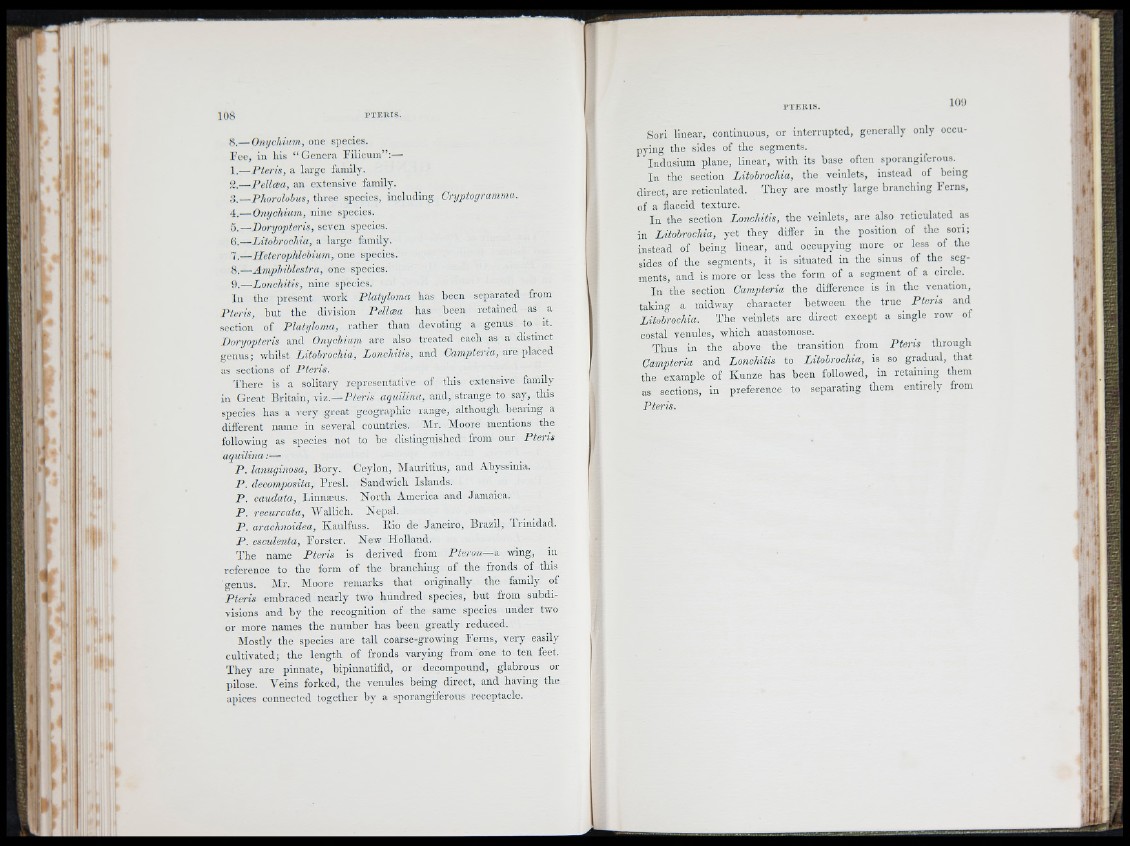
i
lOS I’T EU I S ,
8,— Onijchiitm, one species.
Fee, in liis “ Genera Filicum” :—
1 ,— P te ris, a large family.
2 .—Pellæa, an extensive family.
;J,—Phorolobus, three species, including Cnjptogramma.
4.— Omjcliium, nine species.
O.— Durijopteris, seven species.
6.— Litohrochia, a large family.
7.—lleterophlehium, one species.
8.—Amphible stra, one species,
i),—Lonchitis, nine species.
In the present work P la ty lom a has been separated from
P te ris, b u t the division Pellæa has hecn retained as a
section of P la ty lom a , ra th e r th an devoting a genus to it.
J)on/opteris and Onychium are also tre a ted each as a distinct
genus; whilst Litohrochia, Lon ch itis, and Campteria, are placed
as sections of Ptc ris.
T h e re is a solitary representative of this extensive family
in Great Britain, viz.— P te ris aquiUnu, and, strange to say, this
species has a very gre a t geographic range, although bearing a
different name in several countries. Mr. Aloore mentions the
following as species not to be distinguished from our P tc ris
aquilina :—
P . lanuginosa, Bory. Ceylon, Alauritius, aud Abyssinia.
P . decoinposila, Pre sl. Sandwich Islands.
P . caudata, Linnæus. N o rth America and Jamaica.
P . recurvata, Wallich. Nepal.
P . arachnoidea, Kaulfuss. Ilio de Jane iro , Brazil, ir in id a d .
P . cscidenta, Forste r. New Holland.
T h e name P te r is is derived from P te ro n— à wing, in
reference to the form of the b ranching of the fionds of this
genus. Air. Aloore remarks th a t originally the family of
P te ris embraced n early two h u n d re d species, b u t from subdivisions
and b y the recognition of the same species under two
or more names th e number has been g reatly reduced.
Alostly the species are ta ll coarse-growing F e rn s, very easily
cu ltivated; the len g th of fronds varying from one to ten feet.
They are pinnate, bipinnatifid, or decompound, glabrous or
pilose. A^eins forked, the venules being direct, and having the
apices connected together by a sporangiferous receptacle.
P T E IU S . 19'.)
Sori linear, continuous, or in te rru p te d , generally only occupying
the sides of the segments.
Indusium plane, linear, with its base often sporangiferous.
In the section Litobrochia, tlie veinlets, instead of being
direct, are reticulated. T hey are mostly large branching F erns,
of a flaccid texture.
In the section Lonchitis, the veinlets, are also reticulated as
in Litobrochia, yet they differ in the position of the sori;
instead of being linear, and occupying more or less of the
sides of th e segments, it is situated in the sinus of the segments,
and is more or less the form of a segment of a circle.
In die section Campteria the difference is in the venation,
taking a midway character between the truc^ P te n s and
Litobrochia. The veinlets are d irect except a single row of
costal venules, which anastomose.
Thus in the above the transition from P te ris th ro u g h
Campteria and Lonchitis to Litobrochia, is so gradual, that
the example of K unze has been followed, in retaining them
as sections, in preference to separating them entirely from
Pte ris.
(
I I
h i
h i